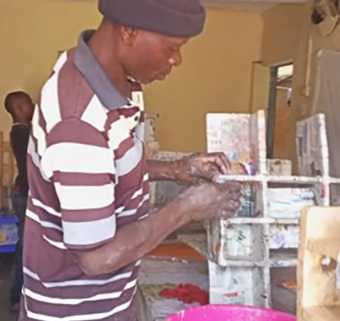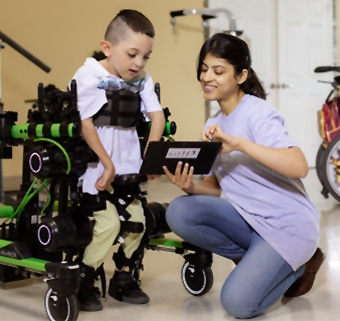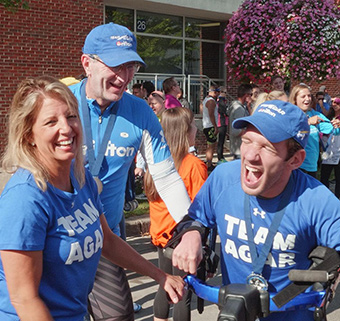Ashley: A Case Story, By Barbara Grajek, MA PT
| March 2007Barbara is a physical therapist serving the Gratiot-Isabella RESD in Mount Pleasant, Michigan.
Ashley, sixteen years old, is one of my students at the Gratiot Isabella Regional Education Service District. She sustained a closed head injury at eleven months of age, and was in a coma for ten days. Her parents were told not to expect her to see, hear, speak or move.
Ashley enrolled with us in 1993, when she was three years old. Since then, Ashley has received PT, OT, and speech therapy. I have been her physical therapist for the past four years.
Ashley’s head injury resulted in quadriplegic spasticity, with more involvement on the right side than the left. Ashley had insufficient back extension strength to sit unsupported, and her posture was extremely kyphotic. She had trouble lifting her head to midline and making eye contact with her classmates and classroom staff.
 The classroom staff understood that Ashley needed to strengthen her trunk and pelvic girdle muscles to have better sitting balance. However, Ashley had found that when she lifted her head up she would lose her balance backward. Because Ashley felt so insecure working on sitting, her tone would increase. If she lost her balance, she had a total-body response in which both hands went up, and she would fall backwards, releasing her left hand hold. So it was difficult for Ashley to be successful at any sitting practice activity. As she got taller and heavier, it became more and more difficult to support her in sitting.
The classroom staff understood that Ashley needed to strengthen her trunk and pelvic girdle muscles to have better sitting balance. However, Ashley had found that when she lifted her head up she would lose her balance backward. Because Ashley felt so insecure working on sitting, her tone would increase. If she lost her balance, she had a total-body response in which both hands went up, and she would fall backwards, releasing her left hand hold. So it was difficult for Ashley to be successful at any sitting practice activity. As she got taller and heavier, it became more and more difficult to support her in sitting.
Ashley also resisted activities that would strengthen her right side. She would never use her right hand spontaneously. She would use her left hand to help support her trunk, but then had no hand free for an activity.This was very frustrating for her and the staff.
As Ashley grew, she developed a right hip subluxation and required surgery. Over time she developed pain in this hip from osteoarthritis. She complained of pain with any position change, and would take a prescription pain medication. We had a seated walker and tried Ashley in it, but she complained of pain and her spasticity increased, making it difficult for her to propel the walker.
In spring 2005, at the direction of our Special Education director, two physical therapists and three special education teachers from our school went to visit the Ottawa Area Center, a model MOVE site. We were impressed with what we saw and encouraged our director to proceed with introducing MOVE to our school district.
 We were able to trial equipment from Rifton: a Pacer, a Wrangler tricycle, a Mobile Stander, an Advancement Chair, and a high back Mobile Chair.We piloted the curriculum in two SXI classrooms. Our initial results were favorable and our district purchased the Rifton products we had received on loan.
We were able to trial equipment from Rifton: a Pacer, a Wrangler tricycle, a Mobile Stander, an Advancement Chair, and a high back Mobile Chair.We piloted the curriculum in two SXI classrooms. Our initial results were favorable and our district purchased the Rifton products we had received on loan.
We have seen progress with students in both classrooms, but Ashley’s progress stands out. She began attending school in a PPI classroom, later moving on to a self-contained SXI classroom. Currently she is in an SCI classroom. Over the years she has always made slow and steady progress, but nothing like we have seen since beginning the MOVE program.
In implementing the MOVE Curriculum, classroom staff made use of the Rifton products. The supportive chair and Mobile Stander helped to stabilize Ashley so that she felt safe while sitting and standing.  She was able to spend time on her feet doing fun things and feeling independent. As her trunk and hip strength improved, we saw increased use of her right upper extremity.
She was able to spend time on her feet doing fun things and feeling independent. As her trunk and hip strength improved, we saw increased use of her right upper extremity.
The goal sheets from the past five years show that her progress had been minimal until beginning the MOVE Curriculum in the fall of 2005. Now, finally, the goals of the Individualized Education Plan (IEP) done on 4-25-05 were all reached by the time of the IEP done on 3-13-06.
That IEP was redone on 10-12-06 when Ashley moved from an SXI classroom at an elementary school, to an SCI classroom at a High School. While we retained the goals, all the percentages were increased. By February 2007, she has already met the new goals set in October of 2006.
These are her motor skills as of March 2007: Ashley can sit in a classroom chair with an attached desk for 30 to 40 minutes at a time. If she loses her balance she can correct independently using her upper extremities. She feeds herself independently although she continues to require help to open milk cartons and cut up her food.
She spontaneously uses her right upper extremity to assist with trunk stabilization, freeing up her left hand for activities. She is able to use both hands when sitting unsupported on the edge of the raised mat.
During therapy we are working on coming to a stand. She is able to use her upper extremities to support part of her weight and once standing, has been able to support her entire weight for up to 20 seconds using both her arms and legs.
 One of Ashley’s favorite activities is pushing herself backwards on a wheeled secretarial chair around the classroom. She is guarded closely in this activity for safety but has not lost her balance, since she is now using both hands on the seat for balance.
One of Ashley’s favorite activities is pushing herself backwards on a wheeled secretarial chair around the classroom. She is guarded closely in this activity for safety but has not lost her balance, since she is now using both hands on the seat for balance.
She is in a gym class with her classmates. She goes to gym in the Mobile Stander, Wrangler tricycle, or the Pacer. She is able to participate in the gym activity, standing for 30 – 40 minutes at a time. She will consistently propel the Pacer for 400 or more feet and can independently propel the tricycle.
Mom reports that it is much easier to dress Ashley, to get her up out of bed, and to bathe her. One of the greatest improvements, however, is that Ashley no longer complains of pain and no longer requires pain medication.
 When Ashley began the MOVE Curriculum, she was asked what she wanted to do. Her response was, “Take my dog for a walk.” She has the skill to do this now in her Pacer, and as soon as the weather cooperates she will do just that.
When Ashley began the MOVE Curriculum, she was asked what she wanted to do. Her response was, “Take my dog for a walk.” She has the skill to do this now in her Pacer, and as soon as the weather cooperates she will do just that.
As Ashley’s therapist, I have been practicing for thirty-seven years, including twenty-four years in school districts. The classrooms that Ashley has been in have been very supportive of therapy goals, following through with activities they were requested to do. The only factor that has changed in Ashley’s life has been MOVE and Rifton.
Ashlie demonstrates the most dramatic improvement I have seen in a student her age, with her wide array of physical challenges, and in such a short span of time. Way to go MOVE and Rifton!
To find out about upcoming MOVE trainings, go to www.move-international.org/move-trainings
or contact:
MOVE International
1300 17th Street
CITY CENTRE
Bakersfield, CA 93301-4533
800-397-MOVE(6683)
FAX: 661-636-4045
e-mail: move-international@kern.org





